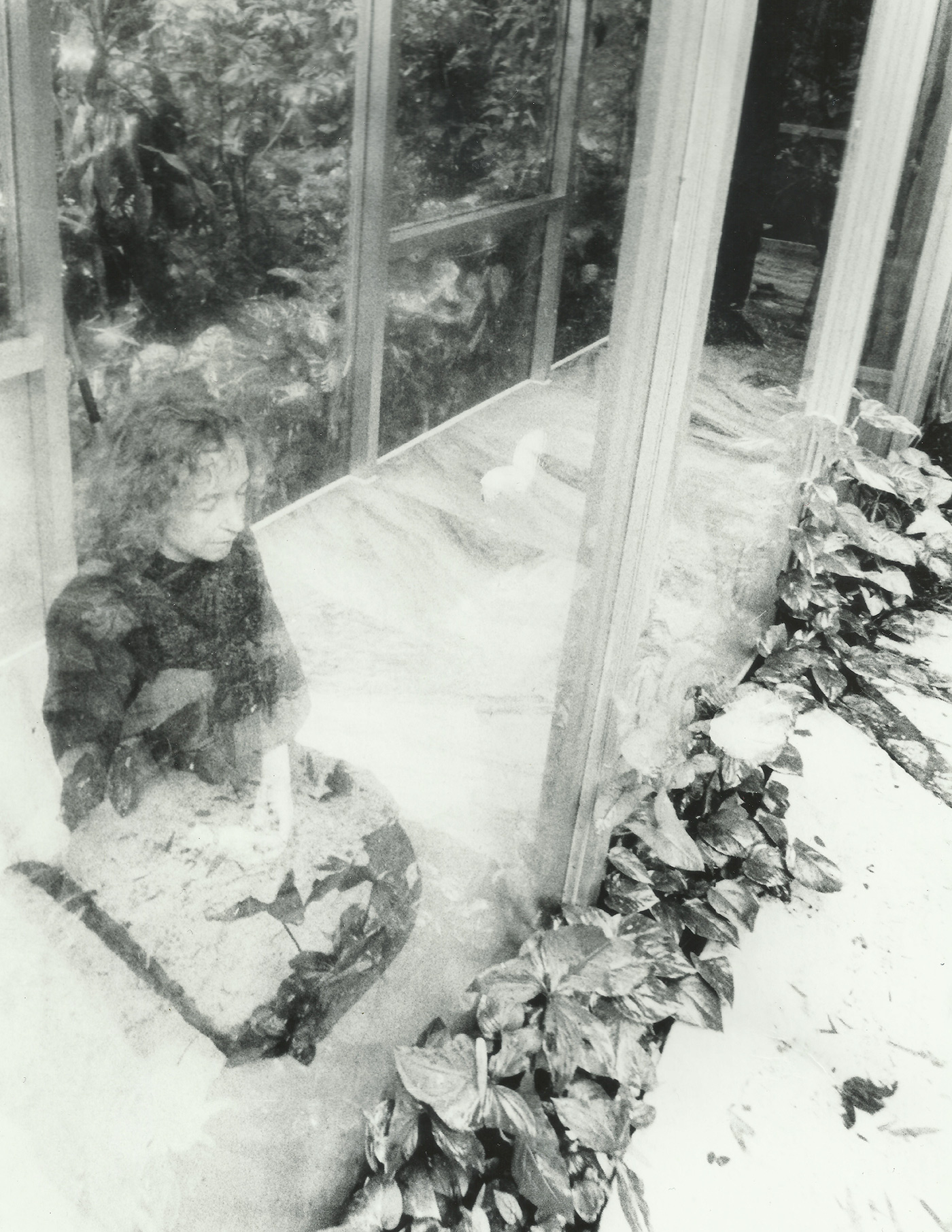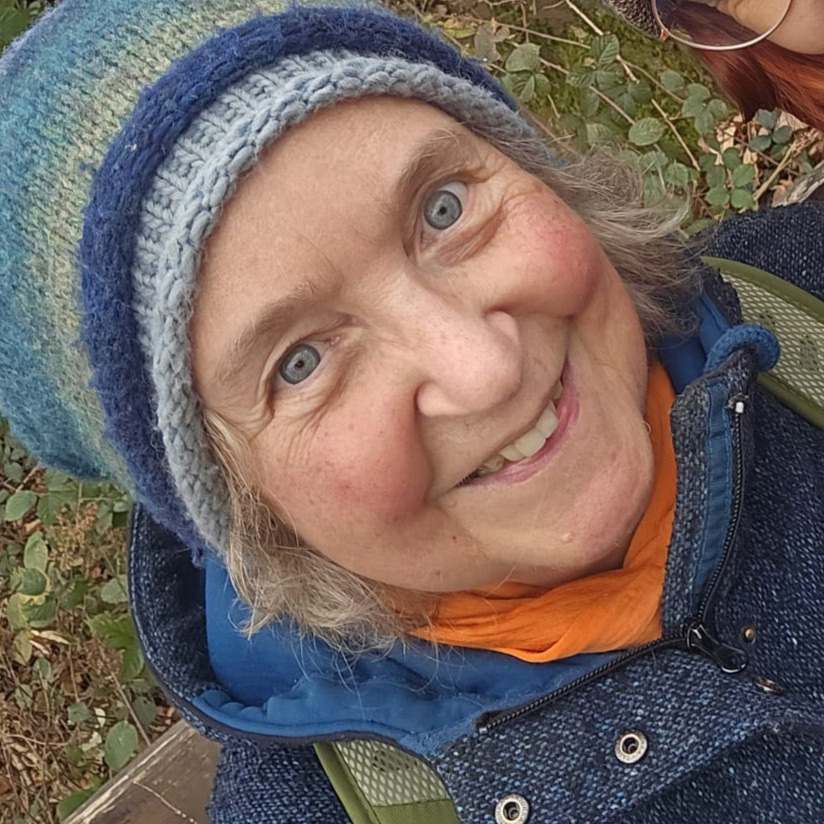Sumukhi, a former Meditation Academy staffer, recalls a fleeting pause in Osho’s glass walkway that opens into a vivid journey through his garden, Zazen, and the magic of silent sitting

What looks like a deeply meditative moment in Osho’s walkway was actually a three-minute pause in the middle of a frantic workday during the high season in Pune, around 1995.
At that time I was working in the Meditation Academy, whose offices were in Lao Tzu House (where Osho used to live). A photographer had been sent by some newspaper to take pictures in Lao Tzu garden, and my coordinator, Pradeepa, had asked me to show him around. Tortured by the mosquitoes in the jungle of Lao Tzu garden, I was quite happy to follow his suggestion to step into the walkway and sit for a photo shoot. It felt so good to just sit still for a moment.
The walkway
The walkway was a magical place. Winding through the lush, jungle-like Lao Tzu garden, it was an air-conditioned glass corridor built over a marble path starting at Osho’s small dining room. It was built in Pune 2 to allow Osho to walk through his garden, sheltered from heat and mosquitoes. He liked it, but used it only a few times. He then gave it to us for silent sitting meditations – Vipassana and Zazen.
After about 100 metres, the walkway ended in a small octagonal glass room. The Octagon had originally had a chair for Osho. Later, we used it for the daily one-to-one talks between facilitator and participants during the Vipassana and Zazen retreats, and to keep our stereo system for announcements and music. Next to the Octagon there was also a glass door out into the garden.
Nature’s Wonders
Walking through Osho’s garden was a journey through a living tapestry. Huge jackfruit trees hung their giant prickly “dinosaur-egg” fruits right from the trunks. Birds small as butterflies and butterflies large as birds flitted past. Sometimes a huge snake slithered right along the glass walls, snacking on the tiny frogs and toads that lined the edge during monsoon season. Now and then a spooky, furred animal ventured through the shrubs – wild and ferocious enough to kill a swan and a peacock.
Then came the massive kapok tree Osho loved so much that the gardeners had to keep it, even though its pods scattered silky kapok fibres everywhere. (I still have many pods, and meditation cushions and pillows filled with that kapok.) There were ponds and tiny waterways between the greenery, marble rocks, and a larger pond with a little waterfall. Once, during a Zazen sitting, I found myself facing a huge toad with golden eyes – pure magic! (That little waterfall’s pump, by the way, often flooded the walkway because of some technical hullabaloo, so mopping the floor became part of the routine of us facilitators.)
Zazen in the walkway
So here I sat in the walkway, happy to have a moment of silence. For me, this photo captures the essence of Osho Zazen: a beautiful chance to watch simultaneously what’s inside and what’s outside – choicelessly.
When Zazen was established in the walkway, Osho was asked whether we should cover the windows with white sheets, as in traditional Zazen one sits facing a wall with open eyes. Osho suggested we leave the windows uncovered so people could enjoy the sight of the garden. That’s one reason Zazen has become my favourite silent sitting meditation.
As a self-described “blessed mindf***er” (I’m an ‘Anand’ after all…), I tend to shoot off into mental movies in Vipassana (with closed eyes), whereas in Zazen the open eyes help me stay still and watchful in that middle space – between inside and out.
Vipassana vs. Zazen
What’s the difference between Vipassana and Zazen? you might ask. In Vipassana our eyes are closed and the primary object of awareness is our breath – the anchor to the present moment. Osho taught us to watch our breath as it moves the belly – not at the nose, as some schools do. “That’s too close to the mind,” I remember Osho saying. Once in a while one might get a gentle tap with a wooden staff – traditionally it’s a whack on the shoulder, but Osho suggests a light, loving tap on the head, to be received with gratitude. That tap helps us to instantly come back from our latest mind movie.
In Zazen there’s no “anchor” like the breath. It’s very pure and Zen: just sitting. The eyes are open, unfocused and slightly lowered. They become passive windows; the inside is silently watched as the outside is silently watched – without focus, intention or concentration.
The 10-minute walks between the sitting sessions differ too: in Zazen you simply follow the person in front. It feels like dissolving into no one and into all of us ‘as one’. Very simple, without an object of awareness.
In Vipassana, on the other hand, we walk like normal, just at a slower pace. One’s awareness is on how the soles of the feet touch the ground at each step. One walks individually, whereas in Zazen there is no object of awareness, one walks ‘as one’ in a line.
Also in Zazen we chant the Heart Sutra in Japanese at the end of each day’s sitting.
Despite their differences, both silent sitting techniques – after a few days – lead me into a delicious relaxation and spacious love.
I would like to add here that, contrary to traditional Zazen and Vipassana, Osho’s version also includes Dynamic Meditation at the start of the day and Kundalini Meditation in the evening. These active meditations are a perfect match with the silent sittings – for both the body and the mind!
Also for the sitting the recommendations are not as strict and rigid. “Meditation is not afraid of chairs,” Osho once told us.* So, it’s not like in traditional settings where we’d have to sit motionless in a classic position.
My first retreat
I remember when I first booked a 21-day retreat, having never done any silent sitting whatsoever before. I was thrilled by the prospect of a new and crazy adventure, but I also thought, “Maybe you’re an idiot, Sumukhi!” To travel all the way from Germany to a place full of beautiful, open, loving people – only to sit for three weeks with closed eyes and, in between, only meet chappals and shoes while walking through the commune.
I discovered that it’s true that love and meditation are two sides of one coin. Inside it felt as if golden honey was slowly sinking through clear water. I became ever more relaxed, loving and open. Magic!
When I worked for the Meditation Academy, Alice and I started offering monthly Full-Moon Zazen Nights. After White Robe and dinner, we would gather at Lao Tzu Gate and then sit – and walk – in Zazen. On rare occasions, we did not stop at midnight but ran through the whole night. In the very early hours, when the commune was still empty and quiet, we would do our walking in Buddha Hall or around the pool in the moonlit silence. We often finished right before Dynamic Meditation started at 6am. I went straight into my workday, without sleep, and felt blissful and loose the whole day, as if for breakfast I had been dunked in a barrel of wine.
Today
Every now and then I love booking a Zazen retreat (mostly with Shunyo & Marco) as a treat for myself. It’s the kind of holiday adventure I really enjoy.
My next one will be in Corfu (20-24 April 2026) (corfubuddhahall.com). We will sit as spring arrives – Corfu is at its most beautiful then! Not only does the grass grow by itself; the air is fragrant with blossoming wildflowers everywhere.
* Osho, The Secret of Secrets, Vol 2, Ch 1





Comments are closed.